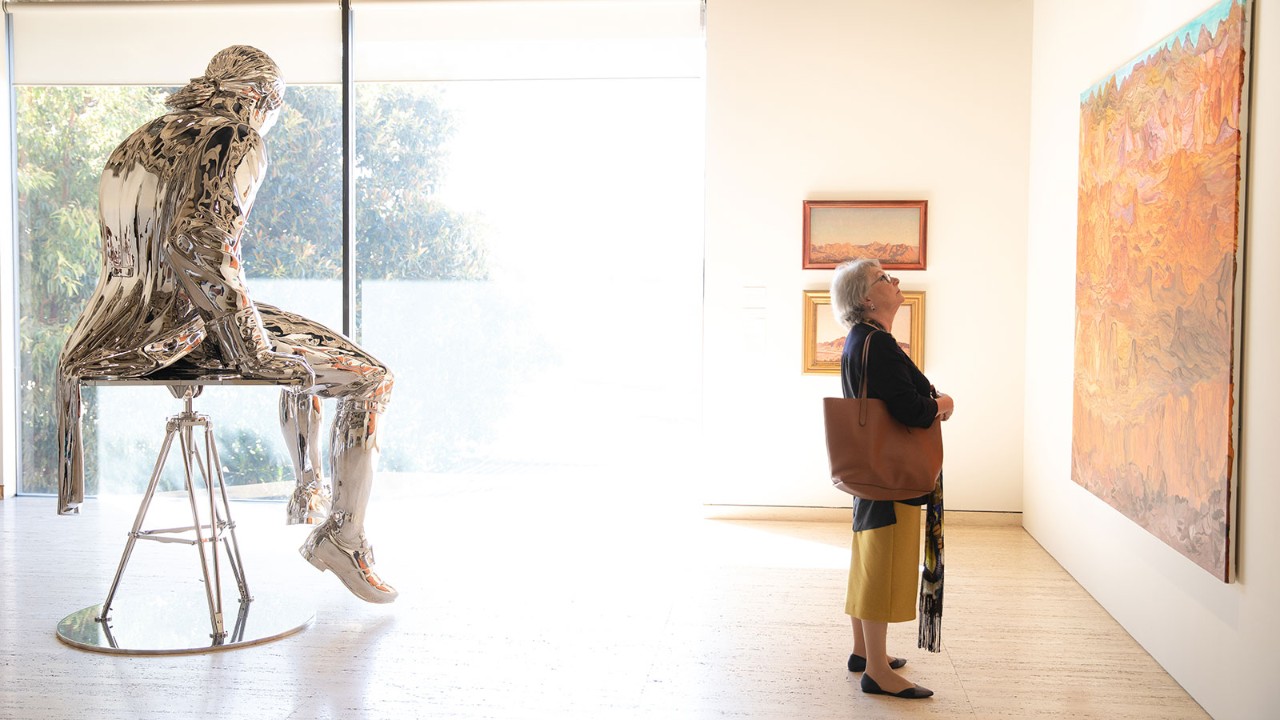
In this article you will learn:
- What corporate sponsorship means
- The long-term benefits for arts institutions
- Innovative ways of engagement
- The business case for sponsorship
An established supporter of arts institutions globally, EY’s longstanding partnerships with museums – including the UK’s Tate galleries and Australia’s Art Gallery of New South Wales – have taken on a renewed significance since the start of the Covid-19 pandemic.
‘We looked at ways to bring art into the homes of our clients and our people. This has never felt more important than right now,’ explains Rebecca Burton, Oceania brand, marketing and communications leader for EY.
Although governments provide varying levels of support for state-run museums, a combination of budget cuts, shifting funding conditions and reprioritisation within the broader cultural sector makes the pursuit of self-sufficiency a common denominator internationally. Along with diverse revenue streams, including ticketing, venue hire and commercial entities such as cafes and shops, corporate sponsorship is an increasingly important source of income.
Why sponsor museums?
Despite banks dominating arts sponsorship globally, accountancy is not far behind. According to sponsorship intelligence firm IEG, the accountancy/consulting sector is the third most active in supporting museums. Increasingly, these partnerships are moving from largely transactional to participatory.
‘I think things have changed a lot in the past few years,’ observes Renai Grace, director/CEO of the Museum of Brisbane in Australia. ‘Even pre-Covid, sponsors were looking at how they could further engage not just their clients but also their staff in partnerships.’
That was the case for KPMG in Belfast, UK, which has been the main sponsor of the Royal Ulster Academy’s annual exhibition since 2007. ‘We were looking for a suitable arts partner that could help KPMG achieve a number of straightforward objectives,’ explains Johnny Hanna, partner-in-charge of Northern Ireland. Those included raising the firm’s brand profile, as well as attractive hospitality opportunities for clients.
The partnership proved a catalyst for several corporate social responsibility projects with schools, and in 2018 KPMG won the Long Term Partnership award at the Arts & Business NI Awards. ‘Obviously, financial support is key,’ Hanna says. ‘But for a sponsorship to be successful, longstanding and mutually beneficial, it needs to be about more than a simple financial transaction.’
Attractive proposition
In Australia, BDO’s relationship with the Museum of Brisbane has developed over the three years it has been in place. ‘Initially, the museum’s family-friendly activities during school holidays were an attractive proposition for BDO as we could offer discounted tickets to our team members,’ explains Brisbane office managing partner Steven Sorbello, of the practice’s partnership, which spans both financial and in-kind support.
‘While we initially used this as an extension of our employer brand activity, we also wanted to strategically support local organisations active in the arts.’
‘For a sponsorship to be successful, longstanding and mutually beneficial, it needs to be about more than a simple financial transaction’
In a competitive marketplace, close alignment with museums can result in positive brand perception, cultural relevance and engagement of local, national and international communities. EY in Australia, for example, has carved a reputation for its strong support of the national art scene. In addition to the Art Gallery of New South Wales, other partners include the National Gallery of Victoria, Opera Australia and Queensland Ballet.
‘EY Australia is a strong supporter of the arts; it goes towards our purpose of building a better working world,’ explains Burton. ‘Through supporting diverse cultures and communities, and supporting the galleries, we are able to assist them in bringing great works to Australia that bring joy to the lives of Australians.’
Increased engagement
Currently celebrating its 150th anniversary and poised to open a major new expansion next year, the Art Gallery of New South Wales has enjoyed a fruitful partnership with EY since 2006. Initially a principal sponsor of a late-night public programming series, the firm’s sponsorship has since evolved to include support of key exhibitions.
‘Sponsorship of the art gallery and Australian cultural institutions generally provides more access to art and culture for more people,’ explains John Richardson, the museum’s director of development.
For the Museum of Brisbane, engaging new audiences is also key, says Grace. In 2012, the still fledgling museum transitioned out of Brisbane City Council to a not-for-profit institution and council subsidiary, with charity status through a newly established trust. As a relatively young institution in the Queensland capital, partnerships have also proven an effective way of building connections and expanding the museum’s demographic.
Long-term commitment
As with most relationships, when it comes to corporate partnerships, longevity is key to developing trust. ‘EY’s support isn’t simply financial; it also regularly takes the form of cross-organisational knowledge-sharing, which has been vital as we’ve weathered the last 18 months together,’ explains Charlotte Reeves, head of corporate partnerships at Tate in London.
EY’s partnership with the UK museums brand began in 2013, initially as a three-year engagement. Fast-forward to today, and the EY Tate Arts Partnership continues to centre on the firm’s title sponsorship of a major annual exhibition.
‘The longer timeframe of the partnership also allows us to form deeper, more meaningful and mutually beneficial relationships that lead to additional projects,’ Reeves says. ‘For example, in 2019 EY provided advisory support, on an in-kind basis, to Tate’s collection care department, working to streamline our workflows.’
Innovation in adversity
Periodic pandemic lockdowns and social-distancing measures have challenged many of the traditional perks of museum sponsorship. In response, museums have pivoted: just as many turned to online solutions to maintain a general public audience, the relationship with corporate stakeholders has become similarly agile.
In the UK and Australia, EY’s online engagement with museum partners has brought about surprising boons. ‘When the pandemic hit, EY Arts transformed into a virtual programme and supporting wellbeing became its central purpose,’ says Michel Driessen, sponsoring partner of EY Arts in the UK. That included Tate-led art therapy workshops for EY staff, the reach of which expanded significantly as individuals involved their children, partners and with whomever they were locked down.
‘When the pandemic hit, EY Arts transformed into a virtual programme and supporting wellbeing became its central purpose’
In Sydney, too, EY’s partnership with the Art Gallery of New South Wales also turned to online solutions with the co-creation of digital content. ‘This has been an exciting evolution of the long-standing relationship and reflects a considered re-evaluation by both organisations about what it means to be connected when art can’t be experienced with others or in person, and how we can reimagine a shared experience of the arts at this time and into the future,’ says Richardson.
The Museum of Brisbane, meanwhile, found that by reducing the size of corporate events – with the support of partners including BDO – participants actually gained increasing value from them.
Future model
The post-pandemic landscape still feels a long way off. But in the meantime, the workarounds established by museums and their sponsors are nevertheless inspiring, and raise new possibilities for not just the mechanics of future relationships, but also clarity around some of the non-tangible benefits that engagement with the arts can bring to corporates.
The business case for sponsorship
‘Businesses need to stop thinking about arts sponsorship as a “nice to have” and start seeing it as mission critical,’ says Joe Dunning of art advisory firm Dunning & Partners, which drives partnerships between art and business.
‘The visual arts attract an outsized young audience,’ he explains. ‘From a corporate perspective, that’s a really important market because over the next 10 years we’re going to see a huge wealth transfer to the millennial generation from the older generation, the likes of which we haven’t seen before.’
Dunning launched his consultancy just months into the Covid-19 crisis after observing the cultural sector’s previously formulaic approach to sponsorship. ‘Before the pandemic, a lot of museums stuck to a template when it came to engaging corporate support: sponsor an exhibition, get your logo on the wall, meet the director, that sort of thing,’ he says. ‘As a result, corporate sponsorship of the arts looked the same pretty much everywhere you went. What that meant was that it became invisible.’
Museums offer a unique benefit that is intrinsic to their identity, and that has proven invaluable these past 18 months.
‘Covid-19 has propelled the need to create a strong local community,’ says Renai Grace, director/CEO of the Museum of Brisbane in Australia. ‘Museums provide access to these audiences.’


